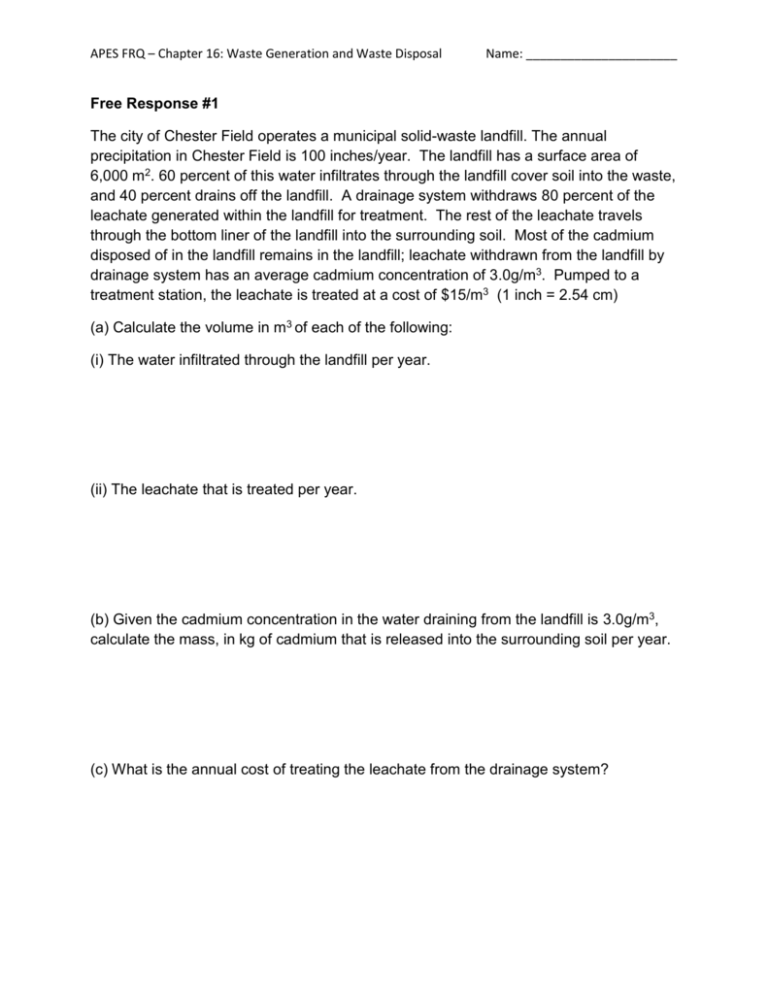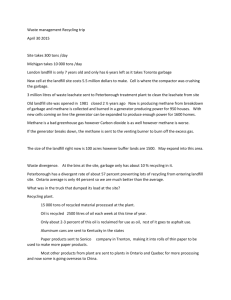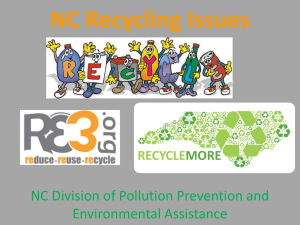Due Monday April 6th
advertisement

APES FRQ – Chapter 16: Waste Generation and Waste Disposal Name: ______________________ Free Response #1 The city of Chester Field operates a municipal solid-waste landfill. The annual precipitation in Chester Field is 100 inches/year. The landfill has a surface area of 6,000 m2. 60 percent of this water infiltrates through the landfill cover soil into the waste, and 40 percent drains off the landfill. A drainage system withdraws 80 percent of the leachate generated within the landfill for treatment. The rest of the leachate travels through the bottom liner of the landfill into the surrounding soil. Most of the cadmium disposed of in the landfill remains in the landfill; leachate withdrawn from the landfill by drainage system has an average cadmium concentration of 3.0g/m3. Pumped to a treatment station, the leachate is treated at a cost of $15/m3 (1 inch = 2.54 cm) (a) Calculate the volume in m3 of each of the following: (i) The water infiltrated through the landfill per year. (ii) The leachate that is treated per year. (b) Given the cadmium concentration in the water draining from the landfill is 3.0g/m3, calculate the mass, in kg of cadmium that is released into the surrounding soil per year. (c) What is the annual cost of treating the leachate from the drainage system? APES FRQ – Chapter 16: Waste Generation and Waste Disposal Name: ______________________ Free Response #2 The county government in one Eastern state initiated an aluminum-recycling program. Most of the Al is in the form of beverage cans. In the first year, the county collected 1.5 x 106 kg of cans; it takes about 65 cans to make a kg. All communities in the country have curb-side pickup of recycled materials. On average, each truck makes a 55-km trip to pick up 5000 kg of Al and gets 10 km/L fuel economy. Each liter of fuel produces 45 000 kJ of energy. (a). How many cans did the county collect in the first year? (b). How many trips were needed to collect all the cans? Please round up. (c). Calculate how many liters of fuel the trucks used to pick up the cans. (d). How many kilojoules (kJ) of energy were consumed collecting the cans? (e). Making cans from recycled aluminum requires about 150 kJ of energy per can. Calculate the total energy needed to make cans from recycled aluminum. This does not include the energy used to collect them. APES FRQ – Chapter 16: Waste Generation and Waste Disposal Name: ______________________ (f). It takes 1520 kJ of energy to make one Al can from bauxite ore. This does not include the energy used to extract the bauxite. Calculate how much energy is needed to make the cans from this virgin ore compared to that of the recycled cans. (g). Calculate the energy difference between the two methods. How many liters of fuel are saved by recycling the cans? Free Response #3 The Chester Field Waste to Energy Facility generates 50 mega watt (MW) of electricity per hour. The shredded refuse is fed into three different boilers at a rate of 15 tons per hour per boiler. The trucks delivering trash (fuel) to the plant have an 70,000 lb capacity of trash when fully loaded. Using the knowledge that all trucks arrive are fully loaded, that there are 2,000 lbs in one ton, answer the following questions. (a) What is the number of trucks arriving each day to keep the plant operating? (b) If the ash produced from the combustion is 10% by mass, how many truck loads of ash must be disposed of in a day from Chester Field? APES FRQ – Chapter 16: Waste Generation and Waste Disposal Name: ______________________ Free Response #4 In many developing countries garbage is still deposited in open dumps. Developed countries have phased out open dumps in favor of landfills or incinerators for handling garbage in the waste stream. (a) describe how a modern-day sanitary landfill is constructed and explain how it is an improvement on the earlier landfills? (b) discuss one benefit and one problem of landfilling waste. (c) Describe how a waste incinerator works and how it could be used to generate electricity. (d) Discuss one benefit and one problem of incinerating waste.








